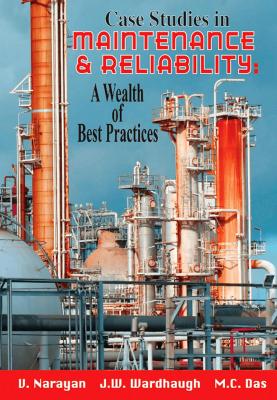Case Studies in Maintenance and Reliability: A Wealth of Best Practices. V. Narayan
Читать онлайн.| Название | Case Studies in Maintenance and Reliability: A Wealth of Best Practices |
|---|---|
| Автор произведения | V. Narayan |
| Жанр | Физика |
| Серия | |
| Издательство | Физика |
| Год выпуска | 0 |
| isbn | 9780831190552 |
We still didn’t have concrete answers or a good understanding of the picture that the benchmarking firm had painted of our performance. However, we found that there was enough factual evidence to identify numerous significant problems:
•Although the refinery had both an overall vision and targets, these had little impact on the efforts made by refinery management and staff. Departments in the refinery were optimizing their efforts based on their own aims rather than on the overall refinery business aims.
•Plant availability at 96% or so was reasonably good for the time. But this level came about largely by providing excessive redundancy of equipment.
•Our reliability effort was unfocused and ineffective. For example, Mean Time Between Failures of pumps was about one year rather than the four years attained by respectable performers.
•Overall costs of doing business were high. For instance, maintenance costs as a percentage of the replacement value of process plant and equipment was over 2% rather than the 1% or less of top performers.
•Maintenance and operations were significantly overstaffed, with too many layers of supervision, and most of the hands-on work was done by over-supervised contractors. Indeed, many of our own fitters had stopped carrying tools as if it was beneath them. This inherent overstaffing was exacerbated by high levels of overtime.
•A huge number of contractor employees arrived at the refinery each day. It was unclear who they were working for, what jobs they were going to work on, and how competent they were. What was certain was that they were having too many accidents.
•There was significant over-management at all levels. Unnecessary authorization hurdles were found; these were causing delays in carrying out fairly mundane activities.
•Productivity was poor with a lot of apparently unnecessary work being done and much of the work being done by a few people. Hands-on-tools time was estimated to be about 30% of the possible time,with many delays.
•A low-risk culture permeated the refinery.
•The Inspection department was consciously acting as a police group separate from the refinery. They looked like employees of the regulatory authorities. There was little apparent business benefit coming from them.
•The Safety department had become emasculated, had no authority, could get little done, and was staffed by inexperienced personnel. The accident rate was increasing.
We wanted to publicize the problems in an easy-to-understand form, so we summarized the findings of the benchmark study and the further internal scrutiny, as in Table 6.1 below.
Table 6.1 Findings of Benchmarking and Internal Scrutiny
6.6 Strategic Decisions on Effecting Change
Contact with the benchmarking firm had jolted us out of our complacency. What was frightening was how easily we had become outdated in our thinking and management styles. The findings of the benchmarking firm and the results of the in-house scrutiny were put to refinery management together with a set of proposals. This prompted a watershed in our thinking about how we were going to operate in the future. Four key decisions were taken which would change things forever:
1.The modern management styles advocated by the benchmarking firm would become our target organizational style (see Figure 6.3, Organizational Characteristics of Top Performers).
2.We would migrate to these as quickly as possible, so that effective change management would be essential (see Section 6.7 below).
3.A set of new computerized information systems would act as enablers (see Section 6.8).
4.The engineering group would be the engine to drive these changes refinery-wide.
Figure 6.3 Organizational Characteristics of Top Performers
6.7 Managing the Change Process
We knew that we were heading for a big upheaval. We were going to change the way the business was run and this would have a significant impact on people at all levels. So we needed a consistent framework in which to manage the changes. The Kotteri approach was chosen.
John Kotteri studied over 100 companies going through change processes and identified the most common errors made as:
•Too much complacency
•Failing to get enough allies
•Underestimating the need for a clear vision
•Failing to clearly communicate the vision
•Allowing roadblocks against the vision
•Not planning and focusing on getting short-term wins
•Declaring victory too soon
•Not anchoring changes in the corporate culture
•Too much management and too little leadership
He made a clear distinction between:
•Management, which is a set of processes to keep complex systems running smoothly and
•Leadership, which defines the future, aligns people, and inspires them to pursue the vision
However, these were the recipes for failure. We were interested in success. For this, Kotter presented an eight-point recipe which we adopted:
1.Establishing a sense of urgency
•Identifying actual and potential major risks or opportunities
2.Creating a guiding coalition
•Assembling a group prepared to act as a team and with enough power to lead the change
3.Developing a vision and a strategy
•Creating a vision to help direct the change effort and developing the strategies for achieving that vision
4.Communicating the vision
•Making effective use of all opportunities to communicate the new vision and strategies, and teaching new behaviors by the example of the guiding coalition
5.Empowering a broad-based action
•Getting rid of obstacles to change; changing systems that seriously undermine the vision; encouraging risk-taking and non-traditional ideas, activities, and actions
6.Generating short-term gains
•Planning for visible performance improvements; creating these improvements; recognizing and rewarding employees involved in these improvements
7.Consolidating gains to produce more change
•Using the credibility achieved from the short-term gains to change systems, structures, and policies that don’t fit the vision; continuous re-invigoration of the transformation process.
8.Anchoring new approaches in the culture
•Getting
